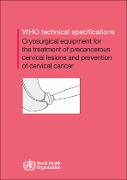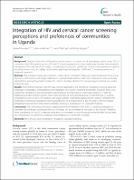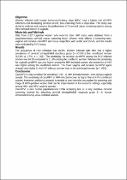Browsing Faculty of Nursing and Midwifery by Issue Date
Now showing items 1-20 of 49
-
Peer-group support intervention improves the psychosocial well-being of AIDS orphans: Cluster randomized trial
(Elsevier, 2009)Accumulating evidence suggests that AIDS orphanhood status is accompanied by increased levels of psychological distress such as anxiety, depression, intense guilt, shame, and anger. However, few studies have examined the ... -
Human papillomavirus vaccine delivery strategies that achieved high coverage in low- and middle-income countries
(Bull World Health Organ, 2011)Objective To assess human papillomavirus (HPV) vaccination coverage after demonstration projects conducted in India, Peru, Uganda and Viet Nam by PATH and national governments and to explore the reasons for vaccine ... -
Occupational exposure to HIV: a conflict situation for health workersinr
(International Nursing Review, 2011)Aim: To determine the frequency of occupational exposure to human immunodeficiency virus (HIV), the circumstances and predisposing factors, the high-risk groups, the extent to which exposures are reported and the ... -
WHO technical specifications Cryosurgical equipment for the treatment of precancerous cervical lesions and prevention of cervical cancer
(WHO, 2012)Cervical cancer is a serious and growing global health issue. In 2008, there were approximately 274 000 deaths from the disease, about 88% of which occurred in developing countries. Although it affects women worldwide, ... -
Consumer Perspectives on a Pericoital Contraceptive Pill in India and Ugand
(2013)CONTEXT: Studies suggest that women in some countries have adopted emergency contraceptive pills as a routine method of family planning. This practice indicates there may be latent demand for a pericoital contraceptive ... -
Screen-and-Treat Approach to Cervical Cancer Prevention Using Visual Inspection With Acetic Acid and Cryotherapy: Experiences, Perceptions, and Beliefs From Demonstration Projects in Peru, Uganda, and Vietnam
(The oncologist, 2013)Cervical cancer is preventable but continues to cause the deaths of more than 270,000 women worldwide each year, most of them in developing countries where programs to detect and treat precancerous lesions are not ... -
Using Formative Research to Design a Behavior Change Strategy to Increase the Use of Improved Cookstoves in Peri-Urban Kampala, Uganda
(International journal of environmental research and public health, 2013)Household air pollution from cooking with biomass fuels negatively impacts maternal and child health and the environment, and contributes to the global burden of disease. In Uganda, nearly 20,000 young children die of ... -
Immunogenicity of bivalent HPV vaccine among partially vaccinatedyoung adolescent girls in Uganda
(Elsevier Ltd., 2014)Background: Investigations of vaccine efficacy and immunogenicity for adult females receiving fewerthan three doses of human papillomavirus (HPV) vaccine have suggested protection against infection andprecancerous lesions. ... -
Integration of HIV and cervical cancer screening perceptions of healthcare providers and policy makers in Uganda
(BMC Public Health, 2014)Background: HIV-positive women have an increased risk of developing cervical cancer (CC) compared to the HIV-negative women. Despite this, HIV and CC screening programs in many developing countries have remained disintegrated. ... -
Feasibility of delivering HPV vaccine to girls aged 10 to 15 years in Uganda
(African health sciences, 2015)Background: Cervical cancer is a leading cause of mortality among women in Uganda. The availability of the human papillomavirus (HPV) vaccine presents an opportunity to prevent cervical cancer. The Government of Uganda ... -
Human Immunodeficiency Virus (HIV), Human Papillomavirus (HPV) and Cervical Cancer Prevention in Uganda
(Örebro university, 2015)Background: HIV-positive women have an increased risk of developing cervical cancer (CC) compared to the HIV-negative women. Despite this, HIV and CC screening programs in many developing countries have remained disintegrated. ... -
Open Access Integration of HIV and cervical cancer screening perceptions and preferences of communities in Uganda
(BMC women's health, 2015)Background: Despite the fact that HIV-positive women carry an increased risk of developing cervical cancer (CC) in comparison with HIV-negative women, HIV and CC screening programs in many developing countries have ... -
Performance of Cervical Cancer Screening Techniques in HIV-Infected Women in Uganda
(Journal of Lower Genital Tract Disease, 2015)Women infected with human immunodeficiency virus (HIV) have a higher risk of HPV infections and developing cervical cancer, thus screening them is imperative. This study was aimed to evaluate and compare the performance ... -
Significantly Reduced Genoprevalence of Vaccine-Type HPV-16/18 Infections among Vaccinated Compared to Non-Vaccinated Young Women 5.5 Years after a Bivalent HPV-16/18 Vaccine (Cervarix1) Pilot Project in Uganda
(2016)The objective of this study was to determine the prevalence and some predictors for vaccine and non-vaccine types of HPV infections among bivalent HPV vaccinated and non-vaccinated young women in Uganda. This was a ... -
Beliefs, perceptions and health-seeking behaviours in relation to cervical cancer: a qualitative study among women in Uganda following completion of an HPV vaccination campaign
(Global Health Action, 2016)Background: Cervical cancer remains a leading cause of morbidity and mortality in Uganda. Despite earlier information campaigns to introduce human papilloma virus (HPV) vaccination, which also targeted cervical cancer, ... -
Assessing the impact of cervical cancer integration into reproductive health networks: operations research from Uganda
(International Population Conference, 2017)The Cervical Cancer Screening and Preventive Therapy (CCS&PT) via Reproductive Health Networks initiative started in 2012, with the aim of improving health outcomes through the provision of services targeted at women at ... -
Cervical cancer risk perceptions, sexual risk behaviors and sexually transmitted infections among Bivalent Human Papillomavirus vaccinated and nonvaccinated young women in Uganda - 5 year follow up study
(BMC women's health, 2017)Background: Previous studies were conflicting regarding the associations between HPV vaccination, cervical cancer risk perceptions, high-risk sexual behaviors and STIs. This study compared the HPV-vaccinated and ... -
Evaluation of a data-informed community engagement strategy to increase immunisation coverage in northern Uganda: a cluster-randomised controlled trial with an embedded process evaluation
(The Lancet Global Health, 2018)Background The 2016 Ugandan Demographic and Health Survey indicated that only 86% of children (aged 12–23 months) in northern Uganda had received the third dose of diphtheria-tetanus-pertussis vaccine (DTP3) and only 65% ... -
Impacts of IRC’s Fifth Child community engagement strategy to increase immunisation in northern Uganda
(2019)The 2011 Uganda Demographic and Health Survey (UDHS) reported that the national coverage of the third dose of the combined diphtheria, pertussis, tetanus vaccine (DPT3) among children 12-23 months of age was 73%, and only ...



















